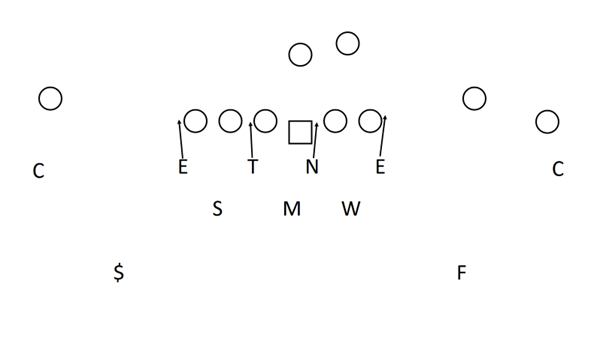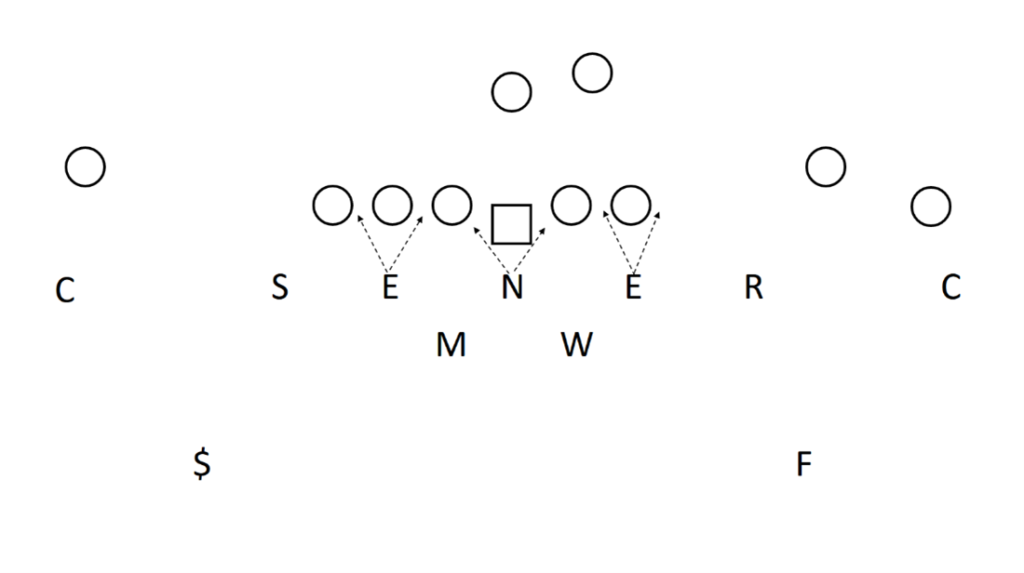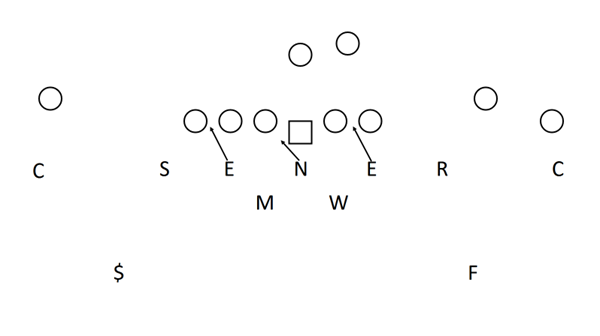Though Stanford boasts such coaching legends as Fielding Yost, Walter Camp, Pop Warner and Bill Walsh, none orchestrated a turnaround in Palo Alto like Jim Harbaugh. Inheriting a team with 5 straight losing seasons, no ten-win seasons since 1992, and no Bowl wins since 1996, Harbaugh’s Cardinal achieved a winning season in his second year and 12 wins, an Orange Bowl victory and a No. 4 final ranking in his fourth.
David Shaw had largely continued this success, with five ten-win seasons and six bowl wins in his first eight years. The past three seasons, however, Stanford had only 11 wins combined.
Lance Anderson has coached at Stanford for all 15 years of the Harbaugh and Shaw eras, including the past eight as the defensive coordinator. The 3-4 defense in his time at Stanford has been the backbone of the Cardinal’s “Intellectual Brutality.” But with the recent struggles on the Cardinal defense, Anderson saw fit to change his scheme from the familiar 3-4 to the alien 4-3.
The 4-3 directly addresses the weaker defensive line. In 2018, the Cardinal’s last season with 9 or more wins, the defense saved .35 Total Points per play against the run and .20 Total Points per play when rushing the passer. In 2021 those numbers dropped to .26 and .13 respectively, largely due to its anemic line play. With only one player with significant reps returning from last season’s defensive line, the Cardinal need to rebuild an already lackluster unit.
Stanford cannot solve this problem with recruiting and transfers alone. Its high academic standards make recruiting difficult already. With a smaller player pool from which to choose, a few misjudgments in high school talent can seriously affect the future of the program. While the transfer portal can offer schools a second chance to plug holes in the roster, Stanford’s selectivity in admitting transfers does not allow for such redemption.
With the weaker development of the past and the anticipated recruiting difficulties of the future, the Cardinal saw fit to switch to the 4-3. While putting an extra player from a weak unit on the field does not make intuitive sense, the 4-3 typically helps defenses with smaller, less talented linemen.
All defenses must cover every gap in the run game and every receiver in the pass game. The 4-3 defense normally does this with four down linemen covering one gap apiece and the linebackers and perhaps a defensive back covering the rest, as displayed below:

The 3-4 requires the defensive linemen to either cover two gaps each by controlling an offensive lineman or slant to a gap away from their alignment, both displayed below:

—

Covering two gaps requires more size and strength, slanting to one gap requires more speed, and both require more skill than filling one gap. The additional lineman relieves the extra responsibilities of the other three.
Though basing out of a 3-4 the past 15 years, the Cardinal are no strangers to the 4-3. In 2021, Stanford played 22% of its defensive snaps in a four-man front, 12th among the 77 teams that played the majority of their snaps with three down linemen.
Adjusting to its failures in the 3-4 as the season progressed, Stanford played with four down linemen nearly twice as often in its final six games as in its first six. The Cardinal even based out of the 4-3 in their bout with Oregon State, playing 46 of their 76 downs with four linemen.
Stanford’s results with the 4-3 last season do not inspire confidence in the switch for 2022. The Cardinal gave up nearly 6.7 yards per play with four down, placing 56th among the 64 FBS teams that played 100 snaps or more with four linemen. In the aforementioned Oregon State game, Stanford allowed 218 rushing yards, 257 passing yards, and 35 points in a loss reminiscent of the beatings Stanford laid on Oregon State just a few years ago.
But with a year of experience and an offseason to implement the scheme, the 4-3 experiment is not doomed to fail. The Cardinal return four of their seven backfield defenders, all seniors. Chief among them is potential first round pick Kyu Blu Kelly at cornerback. With some help from the back end of the defense and additional scheming from Lance Anderson, the Cardinal could see some early returns on their long-term strategic change.
The schematic change may offer Anderson more ways to stop the run. The 4-3 allowed the Cardinal to put enough bodies in the box to try to stifle the Oregon State rushing attack. A few times the defense got the stop:
Other times the Beavers successfully ran away from the tight end:
or passed outside the box against isolated coverage.
With more time in the 4-3 and a few adjustments by the coaching staff, the Cardinal can find more ways to better align their players to defend the run without giving up an easy pass.
In passing situations, Anderson will need to get creative with Stanford’s rush. The Cardinal sacked the quarterback a measly 9.9% of the time in 2021, good for 117th among FBS teams. In Stanford’s first game of the 2022 season, Anderson showed his defense will blitz with the linebacker:
blitz with the safety:
stunt:
and both blitz and stunt:
to put more pressure on the passer. The Cardinal got to Colgate quarterback Michael Brescia on each of these pass rushes, but will need they keep the quarterback in the pocket, as they failed to do here:
This lack of discipline plagued the Cardinal last season, and the better quarterbacks in the Pac 12 will take advantage of these miscues.
Stanford’s response to their current defensive problems makes sense. The Cardinal will always have trouble getting talent to Palo Alto, and those problems will not lessen any time soon. Given the proper implementation of the 4-3, Stanford may have found the best way to revive the “Intellectual Brutality” of the 2010s.

